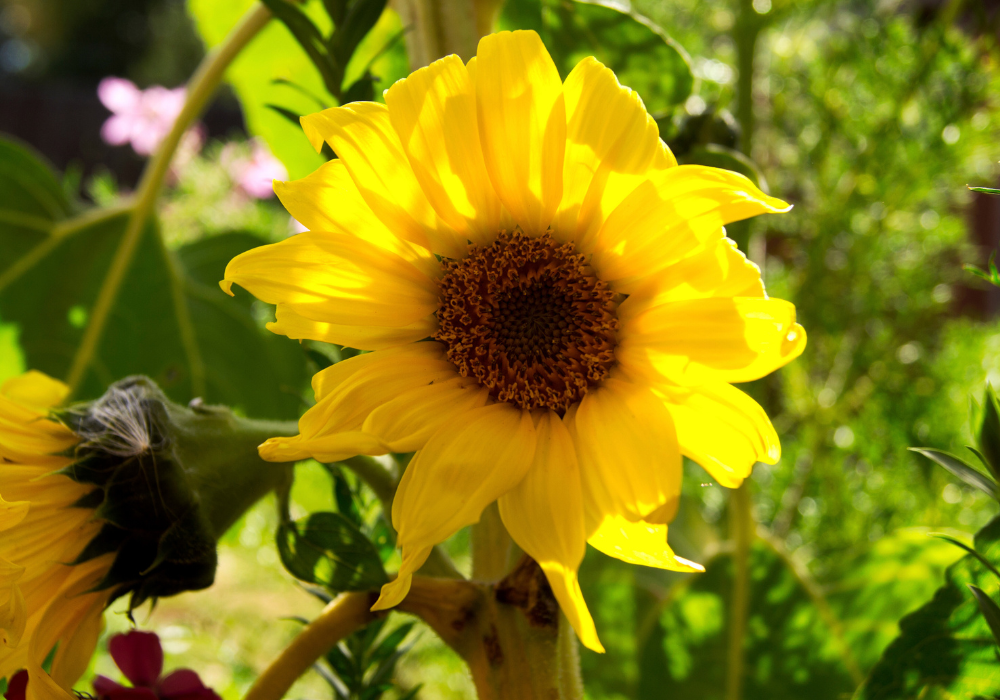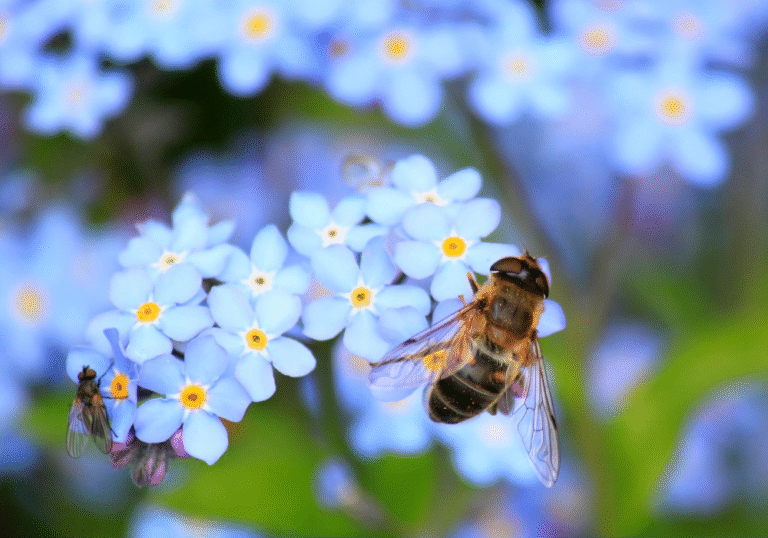#Plants #Attract #Bees #Home #Garden
Last Updated on April 28, 2025 by April

Plenty of gardeners want to help out local bees and boost pollination in their yards, but it’s not always obvious where to start. Choosing the right plants can really make a difference, drawing in bees and adding a bit of wild energy to the garden.
Opting for flowers and shrubs that do well in a range of climates means more people can join in, no matter where they live. Adding bee-friendly plants is probably one of the easiest ways to make any outdoor space feel more alive and productive.
Lavender

Lavender is famous for its fragrant purple blooms and how much bees love them. It’s happiest in USDA hardiness zones 5 to 9.
This perennial likes full sun and well-drained soil. Lavender gets a steady stream of bee visitors all season long, so it’s a go-to for pollinator gardens.
Pruning now and then keeps it tidy and encourages more flowers. It also handles drought surprisingly well, making it a solid pick for lots of garden types.
Sunflower

Sunflowers (Helianthus annuus) are hard to miss with their big yellow heads, and bees sure don’t overlook them either. They’re loaded with pollen and nectar, so they’re a staple for many bee species.
Best in USDA zones 2 through 11, sunflowers need full sun and well-drained soil. Their tall stems make them easy for bees to spot and reach.
Borage

Borage (Borago officinalis) is an herb with star-shaped blue flowers that bees can’t seem to resist.
It grows well in USDA zones 2-11 and likes full sun with well-drained soil.
Borage flowers for a long stretch, so pollinators get a steady buffet. Plus, those blue blooms add a splash of color to any garden.
Coneflower

Coneflower (Echinacea) stands out with its sturdy stems and daisy-like flowers. Bees flock to the blooms for nectar and pollen.
It’s reliable in USDA zones 3 to 9 and doesn’t fuss much about soil. Coneflower prefers full sun and puts on a show from summer into fall.
Once established, it’s low maintenance and drought tolerant. Native bees in particular seem to love it.
Bee Balm

Bee balm (Monarda) draws in bees with its bright, tubular flowers in shades of red, pink, purple, and white.
It does best in USDA zones 4 to 9, preferring moist soil and a sunny spot.
Bee balm can get up to 4 feet tall, and its flowers usually pop up from mid to late summer.
Goldenrod

Goldenrod (Solidago spp.) is a perennial with clusters of small yellow flowers, thriving in USDA zones 3 to 9.
Bees show up for the rich nectar and pollen, especially when summer’s winding down. Goldenrod likes full sun and well-drained soil.
It’s just as happy in wild meadows as it is in a home garden, and its late bloom makes it a lifeline for pollinators when other flowers are spent.
Black-eyed Susan

Black-eyed Susan (Rudbeckia hirta) is easy to spot with its bright yellow petals and dark centers. It grows well in USDA zones 3 to 9.
This plant likes full sun and well-drained soils, so it fits right into gardens or wilder spots.
Bees are regulars on Black-eyed Susan’s blooms, which stick around through the summer.
Catmint

Catmint (Nepeta) is a perennial with lavender-blue flowers and aromatic leaves. Bees are drawn to its long-lasting blooms from late spring through summer.
It’s a good fit for USDA zones 4 to 8, thriving in full sun and well-drained soil.
Catmint’s compact habit works well for borders and edges, and once it’s settled in, it doesn’t mind dry spells.
Phacelia

Phacelia is a favorite for its clusters of blue or purple flowers that pull in bees. The nectar and pollen support both honeybees and native species.
This annual is suited for USDA zones 3 to 10 and does best in full sun with well-draining soil. Starting it from seed is pretty straightforward.
Alyssum

Alyssum is a low-growing annual with tiny, fragrant flowers. Bees seem to love its sweet scent and easy-to-reach nectar.
Grow it in USDA zones 5 to 9. Alyssum prefers full sun but manages in partial shade, too.
Its long blooming season, from spring into fall, makes it a handy choice for borders, paths, and containers.
Sedum

Sedum, or stonecrop, is a tough perennial with star-shaped flowers that bloom late in the year—just when bees need them most.
It thrives in USDA zones 3 to 9, preferring well-drained soil and full sun.
Clusters of pink, red, or yellow flowers draw in bees, and sedum barely needs any care once it’s established.
Thyme

Thyme (Thymus vulgaris) is a low, spreading herb with small, clustered flowers that bees visit for nectar. The blooms show up from late spring into summer.
It does well in USDA zones 5 through 9, loving well-drained soil and full sun. Thyme fits neatly into borders, containers, or rock gardens.
Bees seem to favor thyme, and its compact size is perfect for smaller spaces or herb patches.
Milkweed

Milkweed (Asclepias spp.) is well-known for pulling in a variety of bees. Its clusters of fragrant flowers offer a key nectar source in summer.
It’s a perennial for USDA zones 3-9, happiest in sunny spots with well-drained soil.
Native bees and honey bees both visit milkweed, and it’s a magnet for other pollinators like butterflies, too.
Lupine

Lupine puts out colorful flower spikes that bees can’t seem to resist, mostly blooming in late spring to early summer.
It’s suited for USDA zones 4 to 8 and likes well-drained soil in sun or partial shade.
Lupine brings both color and bee activity to gardens, and it’s often mixed into wildflower meadows or borders.
Salvia

Salvia, or sage, is a garden staple with vibrant spikes of blue, purple, or red flowers that bees flock to for nectar.
It thrives in full sun and well-drained soil, and it’s hardy in USDA zones 4-10.
Salvia blooms for ages, is drought-tolerant, and doesn’t ask for much attention.
Cosmos

Cosmos are annuals with daisy-like flowers and feathery leaves. They’re easy to grow from seed and love full sun.
Open flowers loaded with pollen make cosmos a bee favorite. They do well in USDA zones 2-11.
Colors range from pink to white to orange, and they fit right into pollinator gardens or borders. Once they’re up and running, cosmos are pretty low maintenance.
Calendula

Calendula, or pot marigold, has bright orange or yellow blooms that bees visit for nectar and pollen. It works in USDA zones 2-11 and wants full sun.
This annual blooms from spring to fall, offering pollinators a steady food source. Calendula is easygoing and does well in beds or containers.
Hyssop

Hyssop (Hyssopus officinalis) is a hardy perennial herb with spikes of small blue, pink, or white flowers in summer—bees are definitely fans.
It’s best suited for USDA zones 4 to 9 and likes well-drained soil with plenty of sun. The aromatic leaves and long bloom time keep pollinators coming back.
Zinnia

Zinnias put out bright, cheerful flowers that draw bees all summer long. They’re at home in USDA zones 3 to 10.
Full sun and various soils suit them just fine. Zinnias are easy from seed and don’t need much fussing over.
Their open blooms make pollen and nectar easy for bees to reach, so gardeners often tuck them into borders or beds to help out pollinators.
Marigold

Marigolds (Tagetes spp.) are famous for their bright, punchy flowers that seem to call out to bees. You’ll spot these tough plants in USDA hardiness zones 2 all the way through 11.
Their cheerful blooms offer up easy nectar for all sorts of bee species. Marigolds really shine in full sun and prefer soil that doesn’t stay soggy. Lots of folks plant them along borders or tuck them in as companions to other garden favorites.


